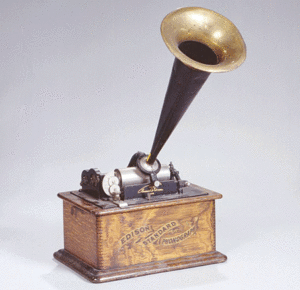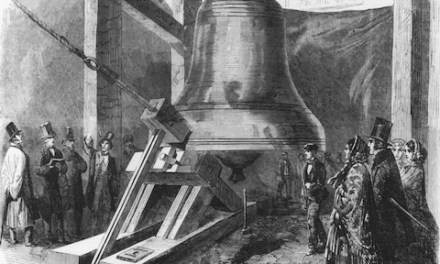
Thomas Edison invented the phonograph and was able to obtain a patent for it in 1877, with the help of a mechanic named John Kreusi.
The year was 1857 and French inventor, Edouard-Leon Scott de Martinville, invented the first “sound” machine that future inventors would take ideas from and expand upon for better machines.
Scott de Martinville invented something called the phonautograph, which recorded sound waves from a horn, with a wire mechanism scratching the wave patterns onto a type of disc that was painted with lamp black.
It was used to identify wave patterns, not sound, visually. This idea spurred along many inventors, and ultimately created what we know now as the phonograph, a machine that changed the way we listen to and record music, as well as the concept of the telephone and other machines that have roots in sound and recordings.
Thomas Edison had always been a curious sort, even as a boy.
As an inventor, he used some of Scott de Martinville’s sound recording ideas and began his first crude machines he called phonographs. Edison was working on telegraphy and wanted a better way to transmit a telegraph message. He wanted to capture Morse code on spools of paper and play back the sound somehow, and extend this idea to telephones.
He wanted to capture the human voice on a recording device, so he looked to the telegraph, studied how to expand upon this idea, and began to experiment.
Scott de Martinville’s concept of a machine that recorded sound came from studying the human ear. He wanted to build a machine that mimicked the inner workings of the human ear and all of the parts that worked together to interpret sound. Edison expanded on this idea and knew that you had to capture sound on an artificial diaphragm, and needed to produce sound from what he recorded. He invented a role with tin foil that would allow a needle to scratch into the surface of the tin when a horn on the outside of the machine caused vibration and made the needle move.
To play back the sound, the listener would take the horn and move it, play back the role of tin into the horn, and hear the same sound. The previous sounds would record the vibrations back to the diaphragm.
Thomas Edison invented the phonograph and was able to obtain a patent for it in 1877, with the help of a mechanic named John Kreusi, who helped him design some of the machinery and working parts from drawings Edison gave him. The machine was able to record and reproduce sound, and with a public showing of the machine that same year, it was a success.
The recording on tinfoil wrapped around a cylinder proved to be fragile and repeated use made them unusable. Edison gave up on his idea for awhile because he had a new baby he was working to invent, his greatest achievement, the light bulb.
Alexander Graham Bell approached Edison in 1880 about working together on Bell’s version of the phonograph. This made Edison very angry, and he refused to work with Bell, accusing him of stealing his ideas for the phonograph.
Edison felt his invention would be best as a business dictating machine, and he is spurred along to go back to his invention after Bell approached him about the machine.
Bell continued to work on the machine, however, and in his Volta Laboratory, he made several improvements to the machine, changing the tin to wax-coated cardboard cylinders and making the needle or stylus move side to side in a zigzag pattern.
Bell’s wax-coated cylinders and cutting stylus was patented in 1886 and called the graphophone. It paved the way to improve on the invention even more, because the wax lasted longer than tin foil.
Bell’s Volta Graphophone Company merged with other companies, and eventually evolved into Columbia Records. The graphophone itself was earlier popular as a dictating machine, but found favor as a slot “entertainment” machine in 1889 in the United States, giving rise to parlors where one could visit and drop a coin into a slot and play the magic machine.
In the 1890s, German-born American Emile Berliner took the idea of cylinders and used a flat disc with a groove running around the edge of a disc, coining the term gramophone. He founded the United States Gramophone Company in 1894. This Berliner invention paved the way for modern day discs that became vinyl in 1949, and records that were seen up into the 20th century, and brought about turntables and ultimately the idea for the compact disc, or CD.
History is full of companies improving on Edison’s ideas. The Victor/Victrola Company, with it’s famous terrier dog staring down into a horn listening to “His Master’s Voice”, improved the phonograph by moving the large horn inside the machine into a cabinet, thus giving rise to the “Victrola”. The horn was large and cumbersome. Some people would throw a pair of socks rolled up into the horn to “control volume”.
The owner of the company, Eldridge Johnson, had once worked for Emile Berliner.
He invented a cabinet to house the gramophone and the doors now controlled the volume, as you could close them or open them on the internal horn.
Eventually, the machines that Edison invented, as well as his counterparts, were produced for the masses.
Aside from the coin “slots” that had been invented for phonograph and graphophone parlors by Louis Glass and William Arnold, from the mid 1890s to the early 1920s, both phonograph cylinder and disc recording machines were sold out on the open market to consumers.
The disc system became more popular and was cheaper, eventually causing Edison to cease his production of cylinders in 1929, ending the rivalry of discs vs. cylinder playing.
The history of the “sound machine” is complicated, full of intrigue, jealousy, research and improvement. The quest to record sound to play back captivated and propelled inventors to ever-improve complicated, expensive machines and adjust them to consumer needs and the times.
As materials and technology improved, so did machines that we once knew with a horn and the first words recorded from Thomas Edison, “Mary had a little lamb.”
(Editor’s note: DeeDee Wood is the store manager at Tharpe Antiques, in Easton, part of the Talbot Historical Society.)




